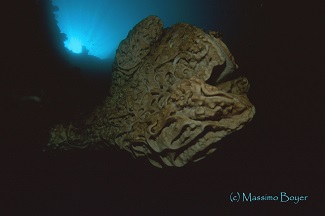Loading content - please wait...
Salvador Dali sponge spawns
Sponge spawning of a Salvador Dali sponge gave divers a glimpse of a rarely witnessed event. Occasionally, Miguel’s Diving staff witness a large sponge releasing sperm into the current. This video records the only time we have witnessed spawning of a Salvador Dali sponge.
Salvador Dali Sponge Spawning
Most sponges are hermaphrodites
, having both male and female reproduction capacity. Other sponges, like Barrel sponges, reproduce by spawning. Males release clouds of sperm into the current. Since the sperm is buoyant, the event looks like the sponge is smoking.A female sponge will release eggs into the current. However, eggs are negatively buoyant, so the eggs sink to the ocean bottom. Some eggs may remain inside the ex-current opening of large vase and barrel sponges. When a female sponge releases her eggs, the nearby area of ocean bottom will look as if snow has fallen there. Miguel’s Diving staff have never seen a female sponge releasing eggs.
In the video of a Salvador Dali sponge spawning, notice the clouds of sperm into the current. This indicates that the sponge is male. No one knows how often a particular sponge will spawn. Miguel’s Diving staff have witnessed simultaneous sponge spawning among numerous sponges over a certain area of reef.
Gorontalo’s Surreal Sponge
When Miguel’s Diving first opened diving in Gorontalo, we discovered a strange and giant sponge. No one had seen this morphology before, although they were quite common on Gorontalo’s deep walls.
The surreal surfaces of this sponge reminded us of the Spanish painter Salvador Dali. So, we began calling it the Salvador Dali sponge.
A Local Morphology of Petrosia lignosa

In order to discover the identity of this unusual sponge, we sent two samples to Nicole J. de Voogd. She was studying sponges at the Institute for Biodiversity and Ecosystem Dynamics, Zoological Museum, University of Amsterdam. The interior bodies of sponges are composed of mazes of microscopic spicules. Each sponge species has a unique pattern. After looking at the two samples we sent under a microscope, Nicole could identify our Salvador Dali sponge. It is Petrosia lignosa.
The genus name Petrosia actually means “stony hard.” When compared with other sponges, all Petrosid sponges are hard and rock-like. So far
, Petrosia lignosa is known only from vertical walls in eastern Indonesia. It was first described in 1925 from the Togian Islands, south of Gorontalo. However, in other locations this sponge lacks the distinctive swirls found on our Salvador Dali sponges.No one knows why this sponge looks so different here in Gorontalo. According to Nicole, the “Salvador Dali sponge” would be a locally unique morphology of Petrosia lignosa.
Although divers cannot expect to witness sponge spawning, Salvador Dali sponges are common in Gorontalo. For your chance to see some for yourself, please make your dive reservations and join us for some great diving.






Sorry, comments are closed for this post.